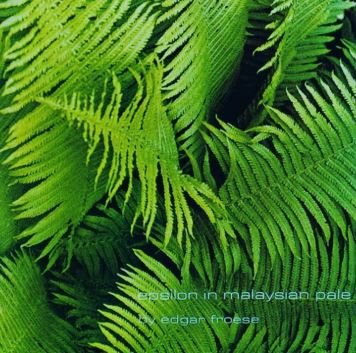Turn down the lights, light up or crack open something suitable, and submerge yourself in this beauty.
Froese was the founder of Tangerine Dream (in 1967) and the band's mainstay throughout their career (until his death in 2015), and 1975 was, for many fans, the peak of TD's career smack bang in the middle of a run of albums starting with Phaedra (1974), through Ricochet and Rubycon (1975), then Stratosfear (1976), that represented not only some of the best music from Tangerine Dream themselves, but some of the best from the whole ambient/electronic/Berlin scene. So it stands to reason Epsilon In Malaysian Pale would present most likely more of the same.
The soundtrack of my life when I lived in Berlin.
David Bowie
And it does. It is a predictable (not in a bad way) extension of the bridge between Tangerine Dream's earliest ambient work (Zeit, Atem) and their later more pulsed sequencer work. A bridge that began on the phenomenal Phaedra album which developed melodic classical string ambience through Mysterious Semblance At The Strand Of Nightmares and made first moves towards gated rhythms through it's title track.
Epsilon continues that bridge. We have two tracks of approximately 15 minutes each (so pleasing the record company have not added superfluous dilutionary padding in the CD release). The first side (in old vinyl terms) is the title track and the second piece is entitled Maroubra Bay.
The titles, inspired by travels in Malaysia and Australia, are typically "TD exotic" (as is the gorgeous rain forest ferned cover - indeed the album begins with rain forest sounds which set a scene of lush green wetness from a land that time forgot - I imagine dinosaurs lurking in the undergrowth and pterodactyls flying overhead, and it's raining, heavily, of course). [That's enough now, Ed.]
It's all gorgeous and moist, like my other go to "green" albums - the "gardens wet with rain" Astral Weeks, and the "water slapping" The Meeting Pool. The cover is important and part of the tangible overall aesthetic - a feeling lost on digital downloads of course, and a subject I've banged on about a lot at this website.
A gorgeous piece of impressionism.
Julian Cope
Side one begins with exotic jungle noise and then a gentle flute (synth) heralds in a beautiful Debussyesque / Vaughan Williams soundscape. It's all lovely and wet... nearly all. There are a couple of jolts which almost sound like sudden tape edits but on the other hand sound entirely deliberate. They keep your interest. At about 9 minutes in, the beauty, most reminiscent of the stringed parts of Phaedra, yet more melodic, gives way to some avant-garde sounds and the first gated synth pulse of the album, and it's actually a slight disappointment. Not that it spoils the piece at all (possibly the peace perhaps) - it's just a bit more "run of the mill" standard TD fayre and out of place for a moment. This section actually fades to silence completely before the padded strings and "flute" return for the conclusion of the track.
My only criticism of some of this type of ambient music is, paradoxically, sometimes the artists throw too much in. Does that make sense? So you'll have a pulsed hypnotic loop or you'll have luscious strings. But sometimes you'll have both, plus a relatively random keyboard solo over the top that sounds a bit like jamming. Some Klaus Schulze (ex-TD) stuff can veer off into such noodling. Set the controls for the heart of the moog and impro. over the top. Anyway, a minor issue, and not much leeway for excess in these two super tight tracks (I have a Schulze track that sprints at a pace for about 50 minutes - it's both amazing and exhausting).
The second half of the album completes the bridge. For the first 5 minutes we have some interesting improvisational chords cutting keen melodic lines like Kraftwerk's Autobahn. Then an insistent hypnotic circular bass synth kicks in. Quicker than most TD tracks the central section bubbles along inducing an almost transcendental state complete with involuntary head nodding and foot tapping. Modest horned synths from the first movement return to do their stuff over the top but this section is all about that gated rhythm. Similar in structure to the first piece, albeit more upbeat, the pulse eventually fades and a wash of broad synth brushstrokes sees out the gorgeous coda.
It's a wonder to discover this old album which comes upon me like a lost Tangerine Dream classic from their most important period. Epsilon In Malaysian Pale deserves its place in the TD pantheon alongside Ricochet and Phaedra.
Editor's note: It is important to seek out the original 1975 recording. A remixed version by Froese himself was released in 2004 to mixed reviews.



0 comments:
Post a Comment